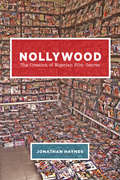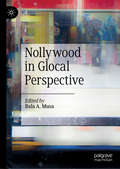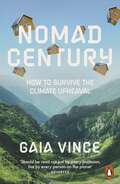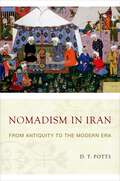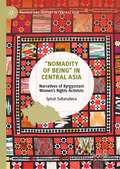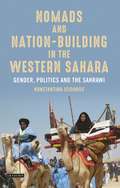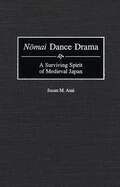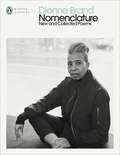- Table View
- List View
Nollywood: The Creation of Nigerian Film Genres
by Jonathan HaynesNigeria’s Nollywood has rapidly grown into one of the world’s largest film industries, radically altering media environments across Africa and in the diaspora; it has also become one of African culture’s most powerful and consequential expressions, powerfully shaping how Africans see themselves and are seen by others. With this book, Jonathan Haynes provides an accessible and authoritative introduction to this vast industry and its film culture. Haynes describes the major Nigerian film genres and how they relate to Nigerian society—its values, desires, anxieties, and social tensions—as the country and its movies have developed together over the turbulent past two decades. As he shows, Nollywood is a form of popular culture; it produces a flood of stories, repeating the ones that mean the most to its broad audience. He interprets these generic stories and the cast of mythic figures within them: the long-suffering wives, the business tricksters, the Bible-wielding pastors, the kings in their traditional regalia, the glamorous young professionals, the emigrants stranded in New York or London, and all the rest. Based on more than twenty years of research, Haynes’s survey of Nollywood’s history and genres is unprecedented in scope, while his book also vividly describes landmark films, leading directors, and the complex character of this major branch of world cinema.
Nollywood: The Creation of Nigerian Film Genres
by Jonathan HaynesNigeria’s Nollywood has rapidly grown into one of the world’s largest film industries, radically altering media environments across Africa and in the diaspora; it has also become one of African culture’s most powerful and consequential expressions, powerfully shaping how Africans see themselves and are seen by others. With this book, Jonathan Haynes provides an accessible and authoritative introduction to this vast industry and its film culture. Haynes describes the major Nigerian film genres and how they relate to Nigerian society—its values, desires, anxieties, and social tensions—as the country and its movies have developed together over the turbulent past two decades. As he shows, Nollywood is a form of popular culture; it produces a flood of stories, repeating the ones that mean the most to its broad audience. He interprets these generic stories and the cast of mythic figures within them: the long-suffering wives, the business tricksters, the Bible-wielding pastors, the kings in their traditional regalia, the glamorous young professionals, the emigrants stranded in New York or London, and all the rest. Based on more than twenty years of research, Haynes’s survey of Nollywood’s history and genres is unprecedented in scope, while his book also vividly describes landmark films, leading directors, and the complex character of this major branch of world cinema.
Nollywood: The Creation of Nigerian Film Genres
by Jonathan HaynesNigeria’s Nollywood has rapidly grown into one of the world’s largest film industries, radically altering media environments across Africa and in the diaspora; it has also become one of African culture’s most powerful and consequential expressions, powerfully shaping how Africans see themselves and are seen by others. With this book, Jonathan Haynes provides an accessible and authoritative introduction to this vast industry and its film culture. Haynes describes the major Nigerian film genres and how they relate to Nigerian society—its values, desires, anxieties, and social tensions—as the country and its movies have developed together over the turbulent past two decades. As he shows, Nollywood is a form of popular culture; it produces a flood of stories, repeating the ones that mean the most to its broad audience. He interprets these generic stories and the cast of mythic figures within them: the long-suffering wives, the business tricksters, the Bible-wielding pastors, the kings in their traditional regalia, the glamorous young professionals, the emigrants stranded in New York or London, and all the rest. Based on more than twenty years of research, Haynes’s survey of Nollywood’s history and genres is unprecedented in scope, while his book also vividly describes landmark films, leading directors, and the complex character of this major branch of world cinema.
Nollywood: The Creation of Nigerian Film Genres
by Jonathan HaynesNigeria’s Nollywood has rapidly grown into one of the world’s largest film industries, radically altering media environments across Africa and in the diaspora; it has also become one of African culture’s most powerful and consequential expressions, powerfully shaping how Africans see themselves and are seen by others. With this book, Jonathan Haynes provides an accessible and authoritative introduction to this vast industry and its film culture. Haynes describes the major Nigerian film genres and how they relate to Nigerian society—its values, desires, anxieties, and social tensions—as the country and its movies have developed together over the turbulent past two decades. As he shows, Nollywood is a form of popular culture; it produces a flood of stories, repeating the ones that mean the most to its broad audience. He interprets these generic stories and the cast of mythic figures within them: the long-suffering wives, the business tricksters, the Bible-wielding pastors, the kings in their traditional regalia, the glamorous young professionals, the emigrants stranded in New York or London, and all the rest. Based on more than twenty years of research, Haynes’s survey of Nollywood’s history and genres is unprecedented in scope, while his book also vividly describes landmark films, leading directors, and the complex character of this major branch of world cinema.
Nollywood: The Creation of Nigerian Film Genres
by Jonathan HaynesNigeria’s Nollywood has rapidly grown into one of the world’s largest film industries, radically altering media environments across Africa and in the diaspora; it has also become one of African culture’s most powerful and consequential expressions, powerfully shaping how Africans see themselves and are seen by others. With this book, Jonathan Haynes provides an accessible and authoritative introduction to this vast industry and its film culture. Haynes describes the major Nigerian film genres and how they relate to Nigerian society—its values, desires, anxieties, and social tensions—as the country and its movies have developed together over the turbulent past two decades. As he shows, Nollywood is a form of popular culture; it produces a flood of stories, repeating the ones that mean the most to its broad audience. He interprets these generic stories and the cast of mythic figures within them: the long-suffering wives, the business tricksters, the Bible-wielding pastors, the kings in their traditional regalia, the glamorous young professionals, the emigrants stranded in New York or London, and all the rest. Based on more than twenty years of research, Haynes’s survey of Nollywood’s history and genres is unprecedented in scope, while his book also vividly describes landmark films, leading directors, and the complex character of this major branch of world cinema.
Nollywood in Glocal Perspective
by Bala A. MusaThis book gives a panoramic view of the rise and growth of Nollywood, Nigeria’s movie and home video entertainment industry, into the second largest and most prolific movie-producing industry in the world. It offers an analysis of Nollywood’s influence as a local and global cultural force. Scholars from Africa, the African Diaspora and beyond examine the factors that have shaped Nollywood’s unique story-telling, production, and distribution system. The volume shows how internal and external economic, social, cultural and technological changes intersect to define Nollywood’s film-making and entertainment ethos. It is grounded in sound theoretical perspectives that help readers understand the texts and subtexts of the industry’s emergence, transformation, and impact. The range of subjects covered span Nollywood’s historical roots in Nigeria pre-colonial traveling/community theatre to colonial era film-making, and its contemporary spin-offs and inspired cousins across Africa and in Europe. It illuminates the interface of artistic, business, cultural and technological innovation and creativity at the heart of Africa’s local and global pop culture explosion.
Nomad Century: How to Survive the Climate Upheaval
by Gaia VinceLonglisted for the Financial Times Business Book of the Year award'Gaia Vince's new book should be read not just by every politician, but by every person on the planet' ObserverAn urgent investigation of the most underreported, seismic consequence of climate change: how it will force us to change where - and how - we liveWe are facing a species emergency. With every degree of temperature rise, a billion people will be displaced from the zone in which humans have lived for thousands of years. While we must do everything we can to mitigate the impact of climate change, the brutal truth is that huge swathes of the world are becoming uninhabitable. From Bangladesh to Sudan to the western United States, and in cities from Cardiff to New Orleans to Shanghai, the quadruple threat of drought, heat, wildfires and flooding will utterly reshape Earth's human geography in the coming decades. In this rousing call to arms, Royal Society Science Book Prize-winning author Gaia Vince describes how we can plan for and manage this unavoidable climate migration while we restore the planet to a fully habitable state. The vital message of this book is that migration is not the problem - it's the solution. Drawing on a wealth of eye-opening data and original reporting, Vince shows how migration brings benefits not only to migrants themselves, but to host countries, many of which face demographic crises and labour shortages. As Vince describes, we will need to move northwards as a species, into the habitable fringes of Europe, Asia and Canada and the greening Arctic circle. While the climate catastrophe is finally getting the attention it deserves, the inevitability of mass migration has been largely ignored. In Nomad Century, Vince provides, for the first time, an examination of the most pressing question facing humanity.
Nomad-State Relationships in International Relations: Before and After Borders
by Jamie LevinThis book explores non-state actors that are or have been migratory, crossing borders as a matter of practice and identity. Where non-state actors have received considerable attention amongst political scientists in recent years, those that predate the state—nomads—have not. States, however, tend to take nomads quite seriously both as a material and ideational threat. Through this volume, the authors rectify this by introducing nomads as a distinct topic of study. It examines why states treat nomads as a threat and it looks particularly at how nomads push back against state intrusions. Ultimately, this exciting volume introduces a new topic of study to IR theory and politics, presenting a detailed study of nomads as non-state actors.
Nomaden, Flaneure, Vagabunden: Wissensformen und Denkstile der Gegenwart (Erlebniswelten)
by Winfried Gebhardt Ronald Hitzler„Nomaden“, „Flaneure“ und „Vagabunden“ werden in diesem Band als personale Bewegungsmetaphern begriffen - als Metaphern einerseits, die in vielfältigen Variationen und Ableitungen in zeitgenössischen Literaturproduktionen auftauchen, als Metaphern andererseits, die geeignet erscheinen, reale Lebensvollzüge in modernen Gesellschaften auf dem Weg ins 21. Jahrhundert als „symptomatisch“ zu etikettieren. Beide Facetten der Metaphorik verweisen somit auf Wissensformen und Denkstile der Gegenwart.
Nomadic and Indigenous Spaces: Productions and Cognitions
by Judith Miggelbrink Joachim Otto Habeck Nuccio Mazzullo Peter KochThis volume is devoted to aspects of space that have thus far been largely unexplored. How space is perceived and cognised has been discussed from different stances, but there are few analyses of nomadic approaches to spatiality. Nor is there a sufficient number of studies on indigenous interpretations of space, despite the importance of territory and place in definitions of indigeneity. At the intersection of geography and anthropology, the authors of this volume combine general reflections on spatiality with case studies from the Circumpolar North and other nomadic settings. Spatial perceptions and practices have been profoundly transformed by new technologies as well as by new modes of social and political interaction. How do these changes play out in the everyday lives, identifications and political projects of nomadic and indigenous people? This question has been broached from two seemingly divergent stances: spatial cognition, on the one hand, and production of space, on the other. Bringing these two approaches together, this volume re-aligns the different strings of scholarship on spatiality, making them applicable and relevant for indigenous and nomadic conceptualizations of space, place and territory.
Nomadic and Indigenous Spaces: Productions and Cognitions
by Judith Miggelbrink Joachim Otto Habeck Nuccio Mazzullo Peter KochThis volume is devoted to aspects of space that have thus far been largely unexplored. How space is perceived and cognised has been discussed from different stances, but there are few analyses of nomadic approaches to spatiality. Nor is there a sufficient number of studies on indigenous interpretations of space, despite the importance of territory and place in definitions of indigeneity. At the intersection of geography and anthropology, the authors of this volume combine general reflections on spatiality with case studies from the Circumpolar North and other nomadic settings. Spatial perceptions and practices have been profoundly transformed by new technologies as well as by new modes of social and political interaction. How do these changes play out in the everyday lives, identifications and political projects of nomadic and indigenous people? This question has been broached from two seemingly divergent stances: spatial cognition, on the one hand, and production of space, on the other. Bringing these two approaches together, this volume re-aligns the different strings of scholarship on spatiality, making them applicable and relevant for indigenous and nomadic conceptualizations of space, place and territory.
Nomadische Bewegungen und die Symbolik der Krise: Flucht und Wanderung in der Weimarer Republik (Historische Diskursanalyse der Literatur)
by Ute GerhardDie Maßnahmen, mit denen Flucht- und Wanderungsbewegungen in der 20er Jahren eine neue Verortung erfahren, reichen von der statistischen Erfassung über paß- und Visumsbeschränkungen bis hin zur "Konzentration" in Internierungslagern. Die Rekonstruktion der diskursiven Prozesse in Wissenschaft, Politik und Medien macht erkennbar, wie in diesem Feld politische und kulturelle Dispositionen entstehen, die sich in den 30er und 40er Jahren verhängnisvoll auswirken. Mit der symbolischen Konstruktion des Nomadischen und seiner Verwerfung stabilisiert sich jene Symbolik der Krise, die die Weimarer Republik mehr oder weniger kontinuierlich durchzog und als Katalysator des Antisemitismus funktionieren konnte. Exemplarische Analysen zeigen, daß auch die Literatur in je spezifischer Weise auf die diskursive Konstellation der Wanderungsbewegungen Bezug nimmt - von unterschiedlichen Figurationen antinomadischer Wanderer bis hin zu J. Roths "Text-Räumen des Nomadischen" und S. Kracauers Ästhetik der "Zerstreuung".
Nomadism in Iran: From Antiquity to the Modern Era
by D. T. PottsThe classic images of Iranian nomads in circulation today and in years past suggest that Western awareness of nomadism is a phenomenon of considerable antiquity. Though nomadism has certainly been a key feature of Iranian history, it has not been in the way most modern archaeologists have envisaged it. Nomadism in Iran recasts our understanding of this "timeless" tradition. Far from constituting a natural adaptation on the Iranian Plateau, nomadism is a comparatively late introduction, which can only be understood within the context of certain political circumstances. Since the early Holocene, most, if not all, agricultural communities in Iran had kept herds of sheep and goat, but the communities themselves were sedentary: only a few of their members were required to move with the herds seasonally. Though the arrival of Iranian speaking groups, attested in written sources beginning in the time of Herodutus, began to change the demography of the plateau, it wasn't until later in the eleventh century that an influx of Turkic speaking Oghuz nomadic groups-"true" nomads of the steppe-began the modification of the demography of the Iranian Plateau that accelerated with the Mongol conquest. The massive, unprecedented violence of this invasion effected the widespread distribution of largely Turkic-speaking nomadic groups across Iran. Thus, what has been interpreted in the past as an enduring pattern of nomadic land use is, by archaeological standards, very recent. Iran's demographic profile since the eleventh century AD, and more particularly in the nineteenth and twentieth century, has been used by some scholars as a proxy for ancient social organization. Nomadism in Iran argues that this modernist perspective distorts the historical reality of the land. Assembling a wealth of material in several languages and disciplines, Nomadism in Iran will be invaluable to archaeologists, anthropologists, and historians of the Middle East and Central Asia.
”Nomadity of Being” in Central Asia: Narratives of Kyrgyzstani Women’s Rights Activists (Politics and History in Central Asia)
by Syinat SultanalievaThis book offers a new framework for understanding feminism and political activiism in Kyrgyzstan, “nomadity of being. ” Here, foreign information and requirements, even forced ones, are transformed into an amalgamation of the new and the old, alien and native—like kurak, a quilted patchwork blanket, made from scraps. Conceptualizing feminist narratives in Kyrgyzstan, while keeping in mind, the complex relationship between ideological borrowing, actualization, appropriation or self-colonization of “feminist” concepts can expand both scholarly and activist understanding of specificities of post-Soviet feminisms from a historiographic point of view. Kurak-feminism is feminism that is half-donor-commissioned, half-learned through interactions (personal, media, academic, professional), unashamed of its borrowed nature and working toward its own purpose that is being developed as the blanket is being quilted. Weaving in elements from completely different and, to a Western eye, incompatible approaches nomadity of being might pave the way toward a Central Asian reframing of non-Western feminisms. This provocative text will interest scholars of European politics, the post-Soviet sphere, and feminists.
Nomadland: Surviving America In The Twenty-first Century
by Jessica BruderThe inspiration for the film Nomadland starring Frances McDormand. ‘A remarkable book’ New YorkerFrom the beet fields of North Dakota to the campgrounds of California to Amazon’s CamperForce program in Texas, employers have discovered a new, low-cost labour pool, made up largely of transient older adults. These invisible casualties of the Great Recession have taken to the road by the tens of thousands in RVs and modified vans, forming a growing community of nomads.Nomadland tells a revelatory tale of the dark underbelly of the American economy – one which foreshadows the precarious future that may await many more of us. At the same time, it celebrates the exceptional resilience and creativity of people who have given up ordinary rootedness to survive, but have not given up hope.
Nomads and Nation-Building in the Western Sahara: Gender, Politics and the Sahrawi (International Library Of African Studies)
by Konstantina IsidorosFabled for more than three thousand years as fierce warrior-nomads and cameleers dominating the western Trans-Saharan caravan trade, today the Sahrawi are admired as soldier-statesmen and refugee-diplomats. This is a proud nomadic people uniquely championing human rights and international law for self-determination of their ancient heartlands: the western Sahara Desert in North Africa. Konstantina Isidoros provides a rich ethnographic portrait of this unique desert society's life in one of Earth's most extreme ecosystems. Her extensive anthropological research, conducted over nine years, illuminates an Arab-Berber Muslim society in which men wear full face veils and are matrifocused toward women, who are the property-holders of tent households forming powerful matrilocal coalitions. Isidoros offers new analytical insights on gender relations, strategic tribe-to-state symbiosis and the tactical formation of 'tent-cities'.The book sheds light on the indigenous principles of social organisation - the centrality of women, male veiling and milk-kinship - bringing positive feminist perspectives on how the Sahrawi have innovatively reconfigured their tribal nomadic pastoral society into globalising citizen-nomads constructing their nascent nation-state. This is essential reading for those interested in anthropology, politics, war and nationalism, gender relations, postcolonialism, international development, humanitarian regimes, refugee studies and the experience of nomadic communities.
Nomads and Nation-Building in the Western Sahara: Gender, Politics and the Sahrawi (International Library of African Studies #10)
by Konstantina IsidorosFabled for more than three thousand years as fierce warrior-nomads and cameleers dominating the western Trans-Saharan caravan trade, today the Sahrawi are admired as soldier-statesmen and refugee-diplomats. This is a proud nomadic people uniquely championing human rights and international law for self-determination of their ancient heartlands: the western Sahara Desert in North Africa. Konstantina Isidoros provides a rich ethnographic portrait of this unique desert society in one of Earth's most extreme ecosystems. Her extensive anthropological research, conducted over eleven years, illuminates an Arab-Berber Muslim society in which men wear full face veils and are matrifocused toward women, who are the property-holders of tent households forming powerful matrilocal coalitions. Isidoros offers new analytical insights on gender relations, strategic tribe-to-state symbiosis and the tactical formation of 'tent cities'.This book sheds light on the indigenous principles of social organization – the centrality of women, male veiling and milk kinship – bringing positive feminist perspectives on how the Sahrawi have innovatively reconfigured their tribal nomadic pastoral society into globalizing citizen-nomads constructing their nascent nation state. This is essential reading for those interested in anthropology, politics, war and nationalism, gender relations, postcolonialism, international development, humanitarian regimes, refugee studies and the experience of nomadic communities.
Nomads in Postrevolutionary Iran: The Qashqa'i in an Era of Change (Iranian Studies)
by Lois BeckExamining the rapid transition in Iran from a modernizing, westernizing, secularizing monarchy (1941-79) to a hard-line, conservative, clergy-run Islamic republic (1979-), this book focuses on the ways this process has impacted the Qashqa’i—a rural, nomadic, tribally organized, Turkish-speaking, ethnic minority of a million and a half people who are dispersed across the southern Zagros Mountains. Analysing the relationship between the tribal polity and each of the two regimes, the book goes on to explain the resilience of the people’s tribal organizations, kinship networks, and politicized ethnolinguistic identities to demonstrate how these structures and ideologies offered the Qashqa’i a way to confront the pressures emanating from the two central governments. Existing scholarly works on politics in Iran rarely consider Iranian society outside the capital of Tehran and beyond the reach of the details of national politics. Local-level studies on Iran—accounts of the ways people actually lived—are now rare, especially after the revolution. Based on long-term anthropological research, Nomads in Postrevolutionary Iran provides a unique insight into how national-level issues relate to the local level and will be of interest to scholars and researchers in Anthropolgy, Iranian Studies and Middle Eastern Studies.
Nomads in Postrevolutionary Iran: The Qashqa'i in an Era of Change (Iranian Studies)
by Lois BeckExamining the rapid transition in Iran from a modernizing, westernizing, secularizing monarchy (1941-79) to a hard-line, conservative, clergy-run Islamic republic (1979-), this book focuses on the ways this process has impacted the Qashqa’i—a rural, nomadic, tribally organized, Turkish-speaking, ethnic minority of a million and a half people who are dispersed across the southern Zagros Mountains. Analysing the relationship between the tribal polity and each of the two regimes, the book goes on to explain the resilience of the people’s tribal organizations, kinship networks, and politicized ethnolinguistic identities to demonstrate how these structures and ideologies offered the Qashqa’i a way to confront the pressures emanating from the two central governments. Existing scholarly works on politics in Iran rarely consider Iranian society outside the capital of Tehran and beyond the reach of the details of national politics. Local-level studies on Iran—accounts of the ways people actually lived—are now rare, especially after the revolution. Based on long-term anthropological research, Nomads in Postrevolutionary Iran provides a unique insight into how national-level issues relate to the local level and will be of interest to scholars and researchers in Anthropolgy, Iranian Studies and Middle Eastern Studies.
Nomads in the Sedentary World
by Anatoly M. Khazanov Andre WinkStudies the role played by nomads in the political, linguistic, socio-economic and cultural development of the sedentary world around them. Spans regions from Hungary to Africa, India and China, and periods from the first millennium BC to early modern times.
Nomads in the Sedentary World
by Anatoly M. Khazanov Andre WinkStudies the role played by nomads in the political, linguistic, socio-economic and cultural development of the sedentary world around them. Spans regions from Hungary to Africa, India and China, and periods from the first millennium BC to early modern times.
The Nomads of Mykonos: Performing Liminalities in a 'Queer' Space (New Directions in Anthropology #29)
by Pola BousiouThis is the ethnography of the Mykoniots d’élection, a ‘gang’ of romantic adventurers who have been visiting the island of Mykonos for the last thirty-five years and have formed a community of dispersed friends. Their constant return to and insistence on working, acting and creating in a tourist space, offers them an extreme identity, which in turn is aesthetically marked by the transient cultural properties of Mykonos. Drawing semiotically from its ancient counterpart Delos, whose myth of emergence entails a spatial restlessness, contemporary Mykonos also acquires an idiosyncratic fluidity. In mythology Delos, the island of Apollo, was condemned by the gods to be an island in constant movement. Mykonos, as a signifier of a new form of ontological nomadism, semiotically shares such assumptions. The Nomads of Mykonos keep returning to a series of alternative affective groups largely in order to heal a split: between their desire for autonomy, rebellion and aloneness and their need to affectively belong to a collectivity. Mykonos for the Mykoniots d’élection is their permanent ‘stopover’; their regular comings and goings discursively project onto Mykonos’ space an allegorical (discordant) notion of ‘home’.
Nomai Dance Drama: A Surviving Spirit of Medieval Japan (Contributions to the Study of Music and Dance)
by Susan M. AsaiNomai dance drama, an artistic expression combining sacred, communal, economic, and cultural spheres of community life in the district of Higashidorimura, is a performing tradition that provides an identity to agriculturally based villages. It has retained features characteristic of the music, drama, and sacred practices of medieval Japan. N=omai singing exhibits traits linked to Buddhist chanting. The instrumental music originates from folk Shinto. This study highlights the social and cultural value n=omaii has for the residents in villages that perform it by providing the historical context in which it is examined, as well as its current performance practices.As this work explores the aspects of agricultural Japanese society, revealed through a dance drama, it will appeal to music and drama scholars as well as students of Japanese culture and history. After establishing the historical lens from which to view n^D=omai drama, the theatrical and musical aspects are discussed in detail. Photographs and musical examples enhance this thorough, well-organized study.
Nomenclature: New and Collected Poems (Penguin Modern Classics)
by Dionne BrandAn immense achievement, comprising a decades-long career - new and collected poetry from one of Canada's most honoured and significant poetsSpanning almost four decades, Dionne Brand's poetry has given rise to whole new grammars and vocabularies. With a profound alertness that is attuned to this world and open to some other, possibly future, time and place, Brand's ongoing labours of witness and imagination speak directly to where and how we live and reach beyond those worlds, their enclosures, and their violences.Nomenclature: New and Collected Poems begins with a new long poem, the titular "Nomenclature for the Time Being," in which Dionne Brand's diaspora consciousness dismantles our quotidian disasters. In addition to this searing new work, Nomenclature collects eight volumes of Brand's poetry published between 1982 and 2010 and includes a critical introduction by the literary scholar and theorist Christina Sharpe.Nomenclature: New and Collected Poems, features the searching and centering cantos of Primitive Offensive; the sharp musical conversations of Winter Epigrams and Epigrams to Ernesto Cardenal in Defense of Claudia; the documentary losses of revolutions in Chronicles of the Hostile Sun, in which "The street was empty/with all of us standing there." No Language Is Neutral connects language, coloniality, and sexuality. Land to Light On explores intimacies and disaffections with nationality and the nation-state, while in thirsty a cold-eyed flâneur surveys the workings of the city. In Inventory, written during the Gulf Wars, the poet is "the wars' last and late night witness," her job not to soothe but to "revise and revise this bristling list/hourly." Ossuaries' futurist speaker rounds out the collection, and threads multiple temporal worlds - past, present, and future.This masterwork displays Dionne Brand's ongoing body of thought - trenchant, lyrical, absonant, discordant, and meaning-making. Nomenclature: New and Collected Poems is classic and living, a record of one of the great writers of our age.
Nomination — fachsprachlich und gemeinsprachlich
by Clemens Knobloch Burkhard Schaeder"Nomination" ist kein eingeführter linguistischer Terminus mit verbindlicher Definition. Allgemein bezeichnet der Ausdruck diejenigen sprachlichen Operationen, mit deren Hilfe ein Sprecher gemeinte Gegenstände, Sachverhalte oder Begriffe dem Hörer verfügbar macht. Die Mittel nominativer Operationen sind teils fertige lexikalische Einheiten, teils aber auch Verfahren, mit deren Hilfe nominative Einheiten fallweise neu gebildet werden. Die Beiträge des Bandes befassen sich mit den linguistischen, psychologischen und terminologischen Aspekten des sprachlichen Nennens.
